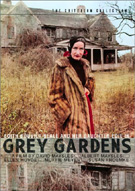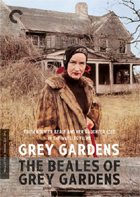Grey Gardens
| Grey Gardens is a documentary that elicits deeply discordant responses, and therein lies its power. It is at once funny and sad, moving and pathetic, intriguing and repulsive. The contradictory nature of its two subjects—79-year-old Edith Bouvier Beale and her 56-year-old daughter Edie Beale, respective aunt and cousin of Jacqueline Kennedy Onassis—infuses the entire film with an edgy uncertainty. Are these two women mentally unbalanced or just willfully nonconformist? Is the film exploitation or heart-felt examination? These are questions that are left dangling when the film is over, and they're hard to shake off. I have the feeling that one of the reasons Grey Gardens developed into a minor cult classic is that the ironic detachment of camp is the only vantage point from which it is comfortable to view it. To take it on its own terms and identify completely with its subjects can be a harrowing experience that is deeply discomfiting. The title of the film comes from the name of the East Hampton, Long Island, mansion in which the two women lived together for more than 20 years. The film opens with a series of newspaper clippings that give us the bare minimum of background. We learn that "Big Edie" and "Little Edie," as they have come to be known, were almost evicted from their own home by the Suffolk County health inspector for the deplorable living conditions (one newspaper article described it as "garbage-ridden and filthy ... with eight cats, fleas, cobwebs, and no running water"). Indeed, the 28-room mansion in which they lived was crumbling from age and lack of upkeep. A series of shots establishes the wealthy, pristine nature of the homes in East Hampton before the camera settles on a shot of Grey Gardens, which resembles a decaying gothic mansion almost entirely consumed by the unchecked plant growth around it, with only the roof and multiple chimneys visible above the towering foliage. Obviously, it was once just as gorgeous as the homes around it, but the harsh effect of time's passage has taken its toll. The destructive nature of time is one of the film's consistent visual and thematic motifs, as decay is everywhere, from the house itself, to Big and Little Edie's memories, to their own aging and badly cared-for bodies. With Big Edie and Little Edie's permission, the Maysles Brothers, David and Albert (best known for Gimme Shelter, their earth-rattling 1970 documentary of the Rolling Stones' ill-fated Altamont concert), took their cameras into the mansion for six weeks in 1974 and emerged with some 70 hours of footage. Grey Gardens is a prime example of their "direct cinema" technique, a form of cinéma vérité in which the Maysles simply let the cameras roll with minimal interaction with their subjects. At the same time, though, they never try to hide their presence (their being there is, in fact, an integral part of the film itself), and the intimate portrait they captured of this odd mother and daughter wavers constantly between genuine in-the-moment reality and what is obviously self-conscious performance. Although the film is relatively short at 94 minutes in length, the filmmakers (the Maysles Brothers did all the filming, and the laborious task of editing their footage into a cohesive narrative fell to Ellen Hovde, Muffie Meyer, and Susan Froemke) create an indelible portrait of the two women without any voice-over narration or awkward journalistic interviewing. Rather, they simply let Big and Little Edie live out their lives before the camera lens. Much of the film consists of conversations, bickering, and reminiscing—but, most of all, simple human interaction, both beautiful and ugly. Sometimes, of course, this involves performative display, the kind that some critics have complained falsifies the reality of the documentary. However, it is an integral characteristic of Big and Little Edie that they are performers, constantly competing with each other for the camera's gaze, and we grow to understand them through what they do on-screen, self-consciously or otherwise. A scene in which Big Edie sings along with an ancient record of "Tea for Two" would probably never have happened had the Maysles not been in the room, but that doesn't mean it is any less effective in conveying to us Big Edie's pride in her voice and her lifelong disappointment that she never became the professional singer she always wanted to be. Similarly, when Little Edie talks directly to Maysles through the camera, proudly discussing her odd wardrobe choice for that day, it is an insight into her persona and how desperately she wants to break free of her mother's control. Would these things have happened had the camera not been there? Possibly not, but that does not imply that these actions are false or meaningless. What people do when they are consciously performing for others is just as telling about who they are as so-called unconscious actions. Much of the film takes place in the cluttered squalor of their tiny bedroom, with Big Edie enthroned on her filthy twin bed while Little Edie moves around the room. They go through old photographs, proudly showing the camera how beautiful they were in their youth (and they were beautiful). Here we begin to get a sense of just how deeply involved they once were in the high society of wealth and privilege that still surrounds them, but from which they are now completely and willfully cut off—they were once part of the closest thing America has to royalty. If the film has a weakness, it is that the past is not explored as thoroughly as it could have been, and thus rich social and historical context is left somewhat vague. The question becomes, then, are Big and Little Edie purposeful noncomformists, or are they mentally unbalanced recluses? That question will be answered differently by different viewers. Many feel a great affinity for these two eccentric women and adore them deeply; others are simply repulsed by their apparent mental haze and complete detachment from reality (for instance, when Little Edie talks about taking care of the house and decorating a bedroom, her comments are strikingly absurd given the dingy and decaying decrepitude of the room she's in). Yet, whether you're drawn to them or repulsed by them, it is impossible to deny that Big and Little Edie are unique, unforgettable people (at one point, Little Edie describes herself quite rightly as a "staunch character"). Their high-society Long Island speech rhythms seem strangely out of place in their surroundings; yet, like the photographs and trinkets that clutter their room, that speech is part of the history of who they were and, in many ways, still are. With Grey Gardens, the Maysles Brothers probably got as close to understanding these women as anyone possible could, and the fact that they still remain enigmatic is testament to their abiding complexity and, perhaps, their ultimate unknowability.
| |||||||||||||||||||||||||||||||||||||||||||||
Overall Rating: 


 (3.5)
(3.5)


 Grey Gardens is available separately (MSRP $39.95) or packaged in a box set with the 2006 film The Beales of Grey Gardens (MSRP $49.95)
Grey Gardens is available separately (MSRP $39.95) or packaged in a box set with the 2006 film The Beales of Grey Gardens (MSRP $49.95)